AMD's Radeon HD 4870 X2 - Testing the Multi-GPU Waters
by Anand Lal Shimpi & Derek Wilson on August 12, 2008 12:00 AM EST- Posted in
- GPUs
General Performance at 2560x1600
We've already established that in games with CrossFire support, the Radeon HD 4870 X2 is the grand poobah of gaming performance. Along with such a title comes a general requirement: if you're dropping over $500 on a graphics card on a somewhat regular basis, you had better have a good monitor - one of many 30" displays comes to mind. Without a monitor that can handle 2560x1600, especially with 2x 4870 X2 cards in CrossFire, all that hard earned money spent on graphics hardware is just wasted.
Since the target resolution here is 2560 x 1600, let's see how the 4870 X2 stacks up in our suite of games at this resolution:
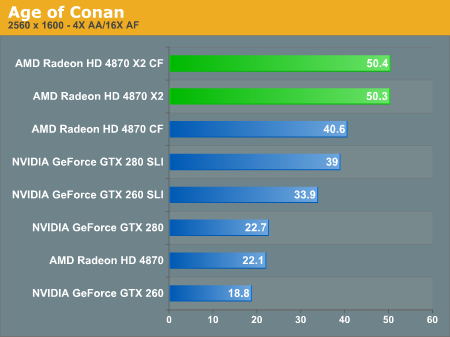
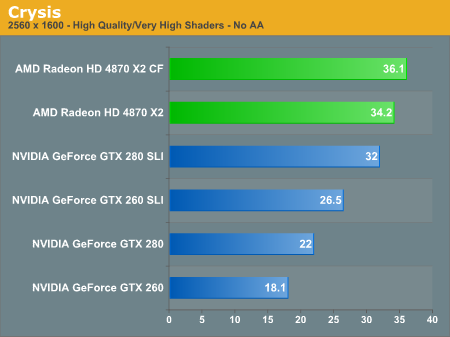
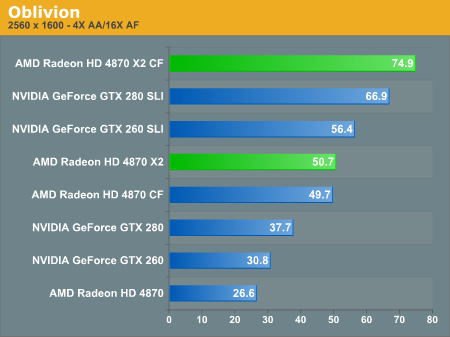
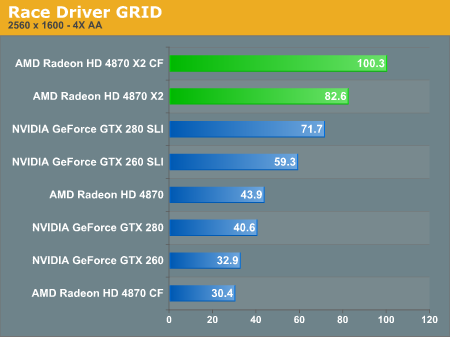
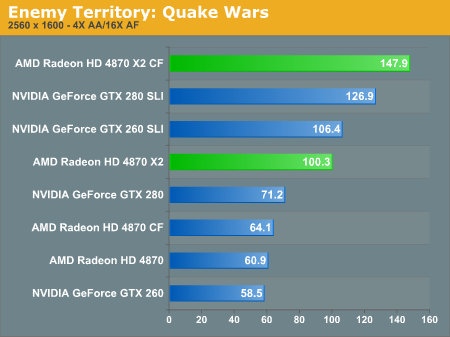
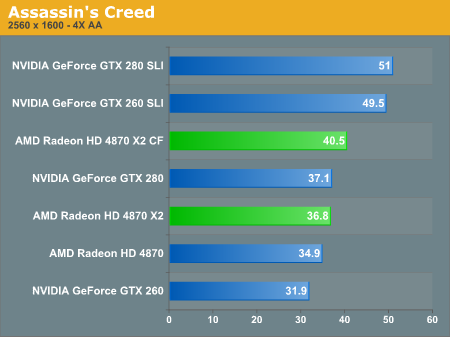
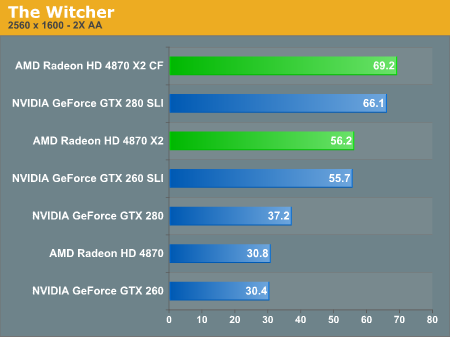
The 4870 X2 holds its own against its major competition from NVIDIA, the GTX 260 SLI, in 4 of our 7 benchmarks, while the 4870 X2 CrossFire leads the pack in all but one game (Assassin's Creed). It is always tough to pick the games we want to test, as the games we pick end up deciding what we think of performance. We try to pick games that are both interesting to the community and/or show interesting performance differences between hardware. In this case, what we have here is a pretty good picture of the general case: the 4870 X2 and GTX 260 SLI are pretty well matched.
Of course, the GTX 260 SLI option is two cards which requires an NVIDIA motherboard. This puts it at a bit of a disadvantage to a single card solution that is platform agnostic. And we also have the fact that at the target resolution of 4870 X2 CrossFire AMD does have the most powerful option that fits into two slots. These are very important factors for AMD, but as we've seen before 4-way solutions aren't the value option (you don't get the same return on your money as you might with other solutions even if you do get high performance).
Taking into account the price drops, we also see the single GPU arena looking very competitive with the GTX 260 and HD 4870 about on par. In these tests, the HD 4870 looks to have an advantage, but again we could add a few more benchmarks and see the GTX 260 do better. This is what we like to see: real competition. Of course, the tough question to answer here is whether or not the GTX 280 is worth 1.5x either the GTX 260 or the 4870.










93 Comments
View All Comments
CyberHawk - Tuesday, August 12, 2008 - link
... but I find a response a bit cold.It's the fastest card for God sake!
Samus - Wednesday, August 13, 2008 - link
it was pretty negative. there really isn't anything negative about this card. price and power consumption (the only arguably negative things about this card) are in line with anything nVidia would have had they made a product to compete against this.Finally - Tuesday, August 12, 2008 - link
And what is this?!"When you start pushing up over $450 and into multi-GPU solutions, you do have to be prepared for even more diminished returns on your investment, and the 4870 X2 is no exception."
Man! This is a bullshit card for bullshit buyers, sry I meant: ENTHUSIASTS... What the heck do you expect? Low power consumption and reasonable price-to-power-relations? I totally don't get it...
Isn't this the "We like power supplies only if they can assure us that they will kill the rain forest single-handedly" site?
Where is the bullshit, sry again: enthusiasm?
Finally - Tuesday, August 12, 2008 - link
Is it just my eyes or did they actually read the following heading on page2?"NVIDIA Strikes Back"
*sound of a Vegas-style gambling automat turning out big coin*
If there was a prize for a totally out-of-order title... this would take rank 1 to 3...
Finally - Tuesday, August 12, 2008 - link
You are right; got that perception, too...Although I would never buy a dualchip cardmonster like this one (save SLI or CF...) I actually love it how they manage to take an article about an AMD product and turn around till you don't know wheter it was about the new HD4870X2 or the lackluster 280...
drisie - Tuesday, August 12, 2008 - link
In my opinion this review is way too negative. It is solutions like this that have caused Nvidia to drop prices and increase competition between the competitors. Its the best card money can buy for ffs.formulav8 - Tuesday, August 12, 2008 - link
Yeps, this is one of the worst reviews Anand himself has ever done. He continues to praise nVideo who just a month or 2 ago was charging $600 for their cards.Give credit where credit is do. He even harps on a sideport feature that doesn't mean much now and AMD says it didn't provide no real benefit even when it was enabled.
I've been a member of this site since 2000 and am dissappointed how bad the reviews here are getting especially when they have a biased tone to them.
Of course, this is only my opinion.
Jason
BikeDude - Wednesday, August 13, 2008 - link
I think Anand's initial comments has to be viewed in the light of his conclusion:"I keep getting the impression that multi-GPU is great for marketing but not particularly important when it comes to actually investing R&D dollars into design. With every generation, especially from AMD, I expect to see a much more seamless use of multiple GPUs, but instead we're given the same old solution - we rely on software profiles to ensure that multiple GPUs work well in a system rather than having a hardware solution where two GPUs truly appear, behave and act as one to the software."
I wholeheartedly agree. The software profile solution has baffled me for years. Why are they messing about with this? It was supposed to be a temporary thing. Creating unique profiles for every game title is not feasible. At the very least give the developers an API that will help them do this themselves.
Instead of messing about with the power hungry sideport nonsense, AMD should have invested some R&D time on how to get rid of software profiles.
Locutus465 - Thursday, August 14, 2008 - link
Probably because from a design perspective it works... And based on the benchmark results it works very well indeed. Additionally we know from the early days of SLI that not all games will respond well to all modes, so it seems to be that at a HW level the task of getting the card to automatically perform amazingly with multiple GPU's is going to be difficult to say the least (perhaps feautal?).EglsFly - Tuesday, August 12, 2008 - link
I agree!It is because of ATI/AMD's release of the 4000 series cards that Nvidia had to dramatically drop the price of its GPU's.
AMD brought great performance to the masses at an affordable price point. Here they up the ante with an even higher performing solution and what do we get in return from Anandtech? A biased review full of negativity that it looks like it was written by somebody from Nvidia.